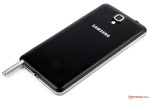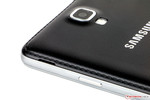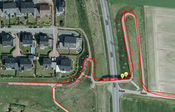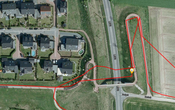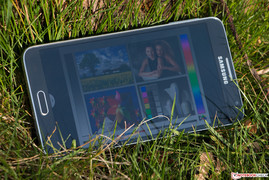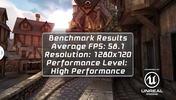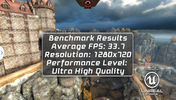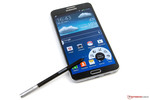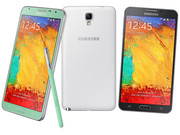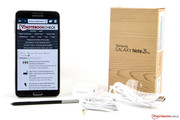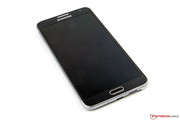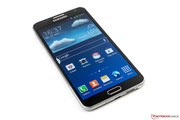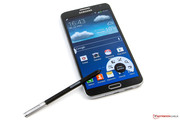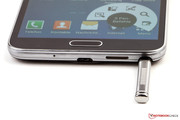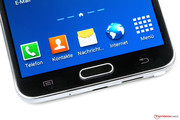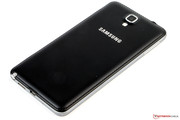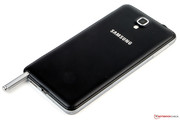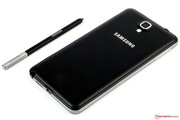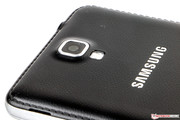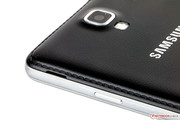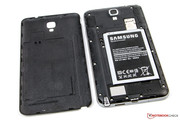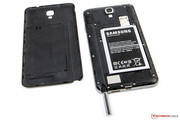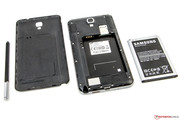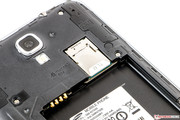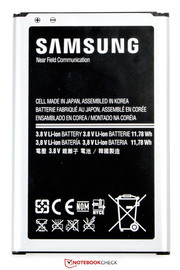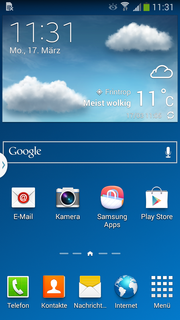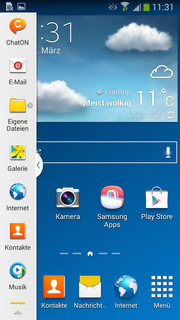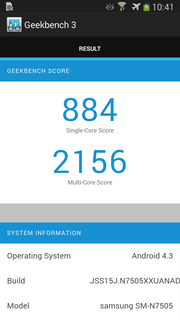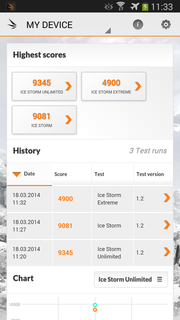Review Samsung Galaxy Note 3 Neo SM-N7505 Smartphone

For the original German review, see here.
Samsung's Galaxy Note 3 Neo SM-N7505 is a light version of the popular Samsung Galaxy Note 3 SM-N9005 that features high-end equipment in all areas. The review sample has also been slimmed down physically. It is slightly thinner and lighter, but also has a smaller, 5.5-inch touchscreen with a resolution of 1280x720 pixels. The biggest modifications are found inside the smartphone. The swift Snapdragon 800 is no longer installed; instead, Samsung uses its own processor with six cores (hexa-core). The working memory has been reduced to 2 GB, and the flash storage has been trimmed by 50 percent. The Neo only has 16 GB here. Those are only a few of the restraints compared with the big brother, which currently only costs 50 Euros (~$68) more. Since the RRP deviates by approximately 200 Euros (~$274), it can be presumed that the difference will increase in the future.
The contenders of the Note 3 Neo that feature an integrated stylus are in particular LG's G Pro Lite Dual (from 259 Euros; ~$355) and Asus' Fonepad Note 6 (from 249 Euros; ~$341). However, Nokia's Lumia 1320 and LG's G Pro are also interesting alternatives.
Case
The casing of Samsung's Galaxy Note 3 Neo corresponds to that of its big brother, but it is a bit more compact due to the smaller screen and battery. The bezel is now sleek, and does not feature the wavy surface of the N9005. The metal look seems very genuine, and the quality build supports this illusion. It is nevertheless plastic.
The smartphone proved to be very stiff, and did not produce any noises when corresponding attempts were made. It is also pressure resistant. Waves or the like are not seen on the screen no matter whether pressure is applied to the screen or display bezel. The gaps are very accurate. Differences in the touchscreen's height are only seen when looking closely. But these discrepancies are below one millimeter.
The Note 3 Neo's battery is removable. The back cover has to be lifted off, and the corresponding notch considerably facilitates this. However, the cover is very thin and does not make a particularly stable impression when removing it. Nevertheless, the smartphone makes an overall very good impression.
Connectivity
Unlike the N9005, Samsung's Galaxy Note 3 Neo does not feature a high-speed USB 3.0 port, but only offers the 2.0 standard. The port is OTG capable and supports connected input devices and USB flash drives.
The micro-SD card slot (SDHC, SDXC) accepts memory cards with up to 64 GB. The S Pen is below the display and can be completely inserted in the casing.
Software
Samsung relies on Google's Android 4.3 operating system, alongside its own TouchWiz interface, for the Galaxy Note 3 Neo. Besides that, loads of Samsung apps are installed, and unfortunately, some pre-loaded apps (bloatware) that cannot be deleted.
The software is identical with that of the Note 3 N9005. The Neo version also has the Multi-Window feature, and thus is capable of real multitasking. We did not discover the issue with the inserted memory card that led to a permanent indexing, which heavily loaded the system and quickly drained the battery.
Communication & GPS
The communication equipment of Samsung's Galaxy Note 3 Neo SM-N7505 is very satisfactory, and is state-of-the-art. The Wi-Fi module supports the IEEE 802.11 a/b/g/n/ac standards, and thus transmits in both the 2.4 and 5.0 GHz frequencies. The components' range is very good. The reception was still decent and Internet browsing possible, even 30 meters (~98 feet) away from the router (Fritz!Box 6360) and through an exterior wall. A router that supports the higher-performance ac standard should achieve even longer ranges. The Note 3 Neo additionally supports Bluetooth 4.0, Wi-Fi Direct, DLNA, and NFC.
The smartphone's mobile data connections are also impressive. Both HSPA+ and LTE (cat. 4 max. 150 MBit/s) are supported with a wide frequency range. This should enable achieving the provider's best possible signal quality. The Internet connection can be shared with others via Wi-Fi, Bluetooth or USB.
The smartphone can determine the position via both GPS and GLONASS. Satellites were found very quickly and reliably even indoors. Unfortunately, this positive impression did not really continue in our practical test performed by bike. Compared with an iPhone 5c or the Garmin Edge 500 navigation system, the components in the Neo are a bit less accurate.
Telephony & Speech Quality
The phone app in Samsung's Galaxy Note 3 Neo is clearly arranged and functionally designed, but looks somewhat nicer than the default version. The standard features for one-handed use are also available so that inputting with smaller hands is possible.
The smartphone's speech quality is at a good level in all areas. Only a quiet background noise is perceptible even when the device is held to the cheek, and noise canceling is enabled. The quality of the included headset surprised us positively, and will serve well.
Cameras & Multimedia
The front-facing camera of Samsung's Galaxy Note 3 Neo has a resolution of 2 MP (1920x1080 pixels), and is well suited for video calls. Owing to the f/2.4 aperture, things can still be recognized even in weak light.
The primary camera has a maximum resolution of 8 MP (3264x2448 pixels, 4:3), and an aperture of f/2.6 as well as an ISO range of 100 to 800. Thus, it is not a low-light specialist. Nevertheless, it shoots decent pictures in good light conditions. The colors are a bit too intense, but do not look unnatural. Besides that, the outlines of high-detail objects blur easily, which is however only seen when looking closely. There are also several picture modes for fast and decent results, and even beginners can shoot usable photos. Videos are recorded in Full HD, but tend to overexpose.
Accessories
There are not many accessories included, as usual. Besides a modular power supply with a power output of 10.6 Watts, we find the matching USB cord. It is for both charging Samsung's Galaxy Note 3 Neo and data sharing with a computer. Besides that, the buyer gets a headset and quick start guide.
Warranty
Samsung includes a 24-month warranty on the smartphone. The battery, cords and headset are only covered for 6 months. It is a bring-in service that cannot be upgraded or extended.
Input Devices & Controls
The touchscreen in Samsung's Galaxy Note 3 Neo enables smooth gliding, and responds quickly and accurately to inputs. The screen does not err even at its edges. Inputting on the screen is not only possible with the fingers, but also with the digitizer, dubbed S Pen. It is completely inserted into the casing. A small menu automatically opens on the screen when it is pulled out, and the most important options optimized for stylus input can be accessed. Thus, the Neo can be used as a simple notepad, but it is also possible to edit screenshots, and to forward them. The S Pen's pressure sensitivity makes it suitable for painting and sketching. The inputs are also accurate, although the screen sometimes responds only on the second try when it is touched too lightly. A bit of familiarization is needed in the beginning.
The virtual keyboard's keys are quite small, but in return, the gaps are quite generous. Typos are rare even in portrait mode. Typing in landscape mode is considerably more comfortable, but the visible content is minimal. Corresponding options for one-handed use can be enabled in the settings. Among other things, it allows dragging a smaller version of the keyboard back and forth, or to minimize the screen's entire content directly, in order to reach even the outermost corner with a thumb.
Display
The screen in Samsung's Galaxy Note 3 Neo has a 5.5-inch size, and a resolution of 1280x720 pixels. This equals a pixel density of 267 ppi, which is quite sharp. The Note 3 N9005 (5.7", 1920x1080 pixels) has a slightly larger Full HD screen, but also uses the brilliant Super AMOLED technology. Samsung does not use break or scratch proof glass.
The screen's maximum brightness of 384 cd/m² is comparatively high for an OLED panel, but does not reach the brightness of an LCD screen. The competition relies on IPS screens, and thus their devices are often much brighter. Asus Fonepad Note 6 (max. 491 cd/m², 88%) is clearly superior, whereas LG's G Pro Lite (max. 409 cd/m², 79%) is only marginally brighter.
| |||||||||||||||||||||||||
Brightness Distribution: 88 %
Center on Battery: 351 cd/m²
Contrast: ∞:1 (Black: 0 cd/m²)
ΔE ColorChecker Calman: 5.43 | ∀{0.5-29.43 Ø4.77}
ΔE Greyscale Calman: 4.84 | ∀{0.09-98 Ø5}
Gamma: 2.42
CCT: 7762 K
Black is always deep black on an OLED screen. Nothing shines through here (0.0 cd/m²), which results in an extremely high contrast ratio with a theoretical tendency to infinity, and which is no longer measurable.
The color accuracy of Samsung's Galaxy Note 3 Neo is quite decent, but a bit unnaturally rich. There are minor shifts in all areas. The light bluish cast is noticed in the grayscale, and blue has the highest rate also in the RGB balance. However, this is not noticed adversely in use.
The viewing angle stability of Samsung's Galaxy Note 3 Neo is very good. That is not very surprising considering the underlying Super AMOLED technology. A minor brightness loss occurs from an angle of 40 degrees. In addition, a light shadow effect is visible from a viewing angle of approximately 120 degrees. It is caused by the gap between the screen and glass. However, this is complaining on a high level, and considerably more pronounced in other devices.
Performance
Samsung's Galaxy Note 3 Neo relies on a homemade processor called Samsung Exynos 5260. At first glance, it looks like a hexa-core CPU, but it is actually a 4 + 2 core system. The SoC works with a quad-core processor that uses ARM Cortex-A7 cores with a clock of up to 1.3 GHz each. Besides that, two Cortex-A15 cores are integrated that operate at 1.7 GHz. Owing to GTS (global task scheduling), it is possible to temporarily use all cores at the same time, and thus increase the performance for a short time.
We experienced problems in the Linpack benchmark. Although the algorithm started, the results ascertained in the single and multi-core scores were virtually identical, and will therefore be neglected. Otherwise, the CPU performance is on par with that of a Qualcomm Snapdragon 800. The Exynos 5260 is within the same range as the premium devices Note 3 N9005 (AnTuTu: 31725, PassMark: 14220) and Sony Xperia Z Ultra (AnTuTu: 23872, PassMark: 15999) with 31228 points in AnTuTu v4 and 15547 points in the PassMark CPU test.
An ARM Mali-T624 graphics unit is installed. The GPU is clearly weaker than the Adreno 330, and performs in the area of the Qualcomm Adreno 320. Thus, the installed graphics chipset has decent performance, and supports the OpenGL ES 3.0 standard. Unfortunately, it is yet unknown how many cores the GPU sports. Samsung has not answered up to now.
However, it supplied good scores in the benchmarks, and places itself in the midfield. The Neo benefits from its low resolution in the onscreen tests in contrast to the premium models. In return, the stronger devices outperform it in the off-screen tests.
| AnTuTu v4 - Total Score (sort by value) | |
| Samsung Galaxy Note 3 Neo N7505 | |
| LG Optimus G Pro Lite Dual D686 | |
| Asus Fonepad Note FHD 6 ME560CG (K00G) | |
| Samsung Galaxy Note 3 SM-N9005 | |
| Sony Xperia Z Ultra | |
| 3DMark | |
| 1280x720 offscreen Ice Storm Unlimited Score (sort by value) | |
| Samsung Galaxy Note 3 Neo N7505 | |
| LG Optimus G Pro Lite Dual D686 | |
| Asus Fonepad Note FHD 6 ME560CG (K00G) | |
| Sony Xperia Z Ultra | |
| 1280x720 offscreen Ice Storm Unlimited Graphics Score (sort by value) | |
| Samsung Galaxy Note 3 Neo N7505 | |
| LG Optimus G Pro Lite Dual D686 | |
| Asus Fonepad Note FHD 6 ME560CG (K00G) | |
| Sony Xperia Z Ultra | |
| 1280x720 offscreen Ice Storm Unlimited Physics (sort by value) | |
| Samsung Galaxy Note 3 Neo N7505 | |
| LG Optimus G Pro Lite Dual D686 | |
| Asus Fonepad Note FHD 6 ME560CG (K00G) | |
| Sony Xperia Z Ultra | |
The browser benchmarks were performed using Google's Chrome 33, and delivered good scores. The review sample is unrivaled in the comparison field in Google Octane V1 and Peacekeeper, which is likely due to the newer browser generation. The platform differences are also noticed here. For example, Nokia's Lumia 1320 Windows phone is faster than the contenders in Sunspider 1.0.
* ... smaller is better
16 GB of flash memory are integrated in Samsung's Galaxy Note 3 Neo. Approximately 11.2 GB are available after initial use. Although the storage's speed is not quite as swift as that of its big brother, it is still fast in the comparison field. LG's G Pro and Asus' Note 6 are only faster in reading small files (4k).
The storage can be expanded up to 64 GB via the micro-SD slot should the internal storage not be enough.
Games
The gaming performance of Samsung's Galaxy Note 3 Neo is quite good due to the installed ARM Mali-T624. There will not be any problems with games from the Play Store because a smooth result is still achieved even using high texture details in the Epic Citadel benchmark (ultra high quality: 33.7 fps).
The good touchscreen, and well-working sensors aptly round off gaming fun.
Emissions
Temperature
The surface temperature of Samsung's Galaxy Note 3 Neo ranges from 26 to 30 °C (78.8 to 86 °F) in idle mode. That is still within an uncritical area. The rates are virtually identical with the SM-N9005.
The rates increase up to 41.2 °C (106.16 °F) in the receiver's vicinity during load. This temperature is not critical, although it is slightly higher than in the Note 3 (max. 39.1 °C; 102.38 °F), and somewhat warmer than the contenders from Asus (max. 38.4 °C; 101.2 °F) and LG (max. 39.5 °C; 103.1 °F). However, these high surface temperatures are only reached in long-lasting load, for example during games.
(±) The maximum temperature on the upper side is 41.2 °C / 106 F, compared to the average of 35.2 °C / 95 F, ranging from 21.9 to 247 °C for the class Smartphone.
(+) The bottom heats up to a maximum of 38.2 °C / 101 F, compared to the average of 34 °C / 93 F
(+) In idle usage, the average temperature for the upper side is 28.4 °C / 83 F, compared to the device average of 32.9 °C / 91 F.
Speakers
We did not expect the mono speaker of Samsung's Galaxy Note 3 Neo to be a sound talent. However, it certainly could have been better. Although bass is relatively clear, the rest of the sound spectrum is very muddy. Playing music is more an annoyance, particularly in maximum volume, and sounds muffled and jarring.
The included in-ear headset makes a good impression though, and it is quite suitable for playing music. The audio jack also does a faultless job.
Energy Management
Power Consumption
The power consumption of Samsung's Galaxy Note 3 Neo is slightly higher than that of the SM-N9005. It already consumes between 0.9 and 1.7 Watts in idle mode. The flagship only needs a maximum of 1.4 Watts. Nevertheless, it is a good rate.
The rates climb up to 5.9 Watts during load. The larger model (max. 6.5 W) is a bit more power hungry here, but it also features a much stronger graphics unit and a somewhat bigger screen. The energy requirement in a turned off state and in standby of 0.1 W is acceptable. The power supply's output of 10.6 Watts (5.3 volts, 2.0 ampere) is designed sufficiently.
| Off / Standby | |
| Idle | |
| Load |
|
Key:
min: | |
Battery Runtime
The 3100 mAh (11.78 Wh, 3.8 V) removable battery of Samsung's Galaxy Note 3 Neo is strong. We ascertained the smartphone's maximum runtime using minimum brightness and only Wi-Fi on. A script that simulates reading a book ran in the browser. The battery was drained after over 18 hours. We determined the Neo's minimum runtime using maximum brightness and all energy consumers on in the opposite scenario. Here, the battery was drained within four hours and 13 minutes via the Stability Test app.
The Wi-Fi test is more real-life. The screen's brightness was set to 150 cd/m², and all energy consumers except Wi-Fi were disabled. A script that opens a new website every 40 seconds was started. The SM-N7505 was drained after 13.5 hours; a very good rate that only the SM-N9005 (18 h) surpasses in the comparison field. The Fonepad Note 6 (9 h 30 min) and G Pro Lite (11 h 35 min) do not last as long. All in all, a very good performance from the review sample.
Verdict
The South Korean manufacturer presents a nicely conceived smartphone with stylus input with the Samsung Galaxy Note 3 Neo SM-N7505. Samsung's new processor provides high performance in the application field. The screen is of a good standard, and only exhibits minor weaknesses in color reproduction. The lowered resolution compared with the SM-N9005 is not really noticed unfavorably.
The smartphone's mobile communication interfaces are particularly great. High-speed LTE and wide frequency coverage barely leave anything to be desired. Everything is state-of-the-art here, and functions perfectly. The build is also of a high standard, and demonstrates that a plastic casing can also be compelling. Additionally, the battery runtimes are quite good.
The biggest point of criticism is certainly that the cutbacks made in GPU, flash memory, RAM, screen and omission of USB 3.0 resulted in such a small price reduction. The series' flagship only costs 50 Euros (~$68) more. The contenders that also offer a stylus are in an even different price range, and it is thus difficult to consider them the Neo's direct rivals. Samsung's smartphone represents a different league, particularly in terms of communication.


